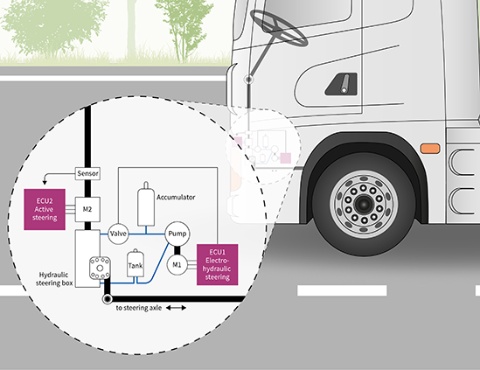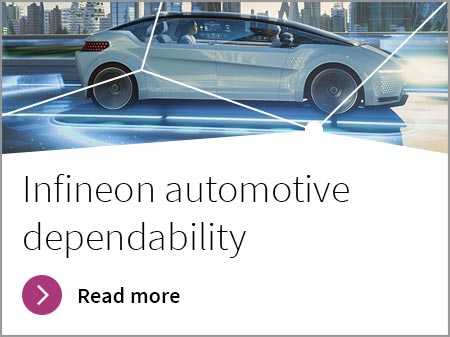24 V EPS with active steering for commercial vehicles
Electric/electro-hydraulic power steering (EPS/EHPS) - active steering for 24 V commercial vehicles in different variants
CAVs (commercial, construction, and agriculture vehicles) require an increasing eco-friendliness, especially for commercial, construction, and agriculture vehicles that need to operate at the highest possible availability and the lowest possible total cost of ownership (TCO). Infineon is constantly improving its semiconductor and system solutions by producing innovative and efficient solutions to address market needs.
Innovative semiconductor solutions for eco-friendly CAV market
Driver assistance systems are expected to increase even more in the CAV market, especially for reducing the risk of accidents, reaching efficient consumption, and better TCO for commercial vehicles.
Even political regulations will have a significant influence on the future of mobility. The upcoming CO2 emission regulations have a strong impact on commercial vehicles, such as buses, trucks, and forklifts.
Electrification of loads and higher voltages are needed as a contribution to a better and greener world. Hence, the new steering for CAV is motivated by major 3 trends: CO2 reduction, upcoming Level 3 and Level 4 automated driving stages, as well as recommendations for costs of insurance (because safer cars will have lower insurance costs). These three factors call for more technical optimizations. China, the USA, and all European regions are affected by these trends and will inevitably implement new electronics-based system solutions.
- Powerful, scalable, small footprint
- Proven interoperability
- Fail-safe and fail-operational EPS
- Aligned safety concept
- Energy savings and CO₂ reduction
- Adaptable: Software updates
- Scalable: Meet future requirements
Full EHPS power steering at anytime
EHPS (Electro-hydraulic power steering) is highly relevant for CO2 reduction. It provides the right amount of torque assistance needed to operate the hydraulic steering systems of industrial vehicles.

Various EPS and EHPS solutions for active steering
ECU1/Level 0-1: EHPS - Pure electro-hydraulic steering benefits (basic and variable EHPS)
- Fuel savings of 0.9 to 1.2%
- CO2 reduction of 6 to 11 g/km
At the same time, using limited sensors, basic EHPS has lower safety requirements compared to more complex steering systems. Due to the need for more automated driving Level 2 and higher, the EHPS and full EPS is and will be state of the art.
ECU2/Level 2: EPS with active steering benefits
- Using EHPS for base functionality
- Adding 1x 3-ph motor to generate torque overlay
- Motivation: reduced accident and insurance costs, active lane keep assist
Level 3-5: Fail-operational EPS benefits
- Full fault-tolerant steering
- Different variants in design
- Variants using hydraulic power
- Variants using electric-only power steering
- Synergies with fault-tolerant EPS for cars
- Motivation: highly automated trucks: Level 3, Level 4
Designed for 24 V commercial, construction, and agriculture vehicles#
EHPS system with active lane following represents the current level of truck automation. ECU2 controls a three-phase motor (M2) acting directly on the steering wheel shaft to provide the torque overlay for system functions such as lane keep assist, lane centering function, or lane-keep steering function.
ECU1 and the three-phase motor (M1) drive the hydraulic pump, replacing the traditional belt drive from the engine. The oil pressure is maintained by an accumulator, which smooths the peak demand so that the M1 motor needs only a relatively low power rating of about 500 W. The sensors provide data on the actual steering wheel position and torque. Combined with additional data via the CAN bus on vehicle speed, lane identification, and object detection, this system allows for higher levels of driver assistance and drive automation.
Assistance systems on the way to automated driving

This whitepaper will introduce the major trends for the commercial, construction, and agricultural vehicles (CAV) vehicles. Infineon’s solutions for fuel efficiency, lower emissions, safety, and connectivity will revolutionize the automated driving market.

In this training you will:
- Know more about Infineon’s wide MOSFET selection for 48 V mild-hybrid electric vehicle, or MHEV, applications
- Understand why and how Infineon is strengthening its position in the 40 V MOSFET market, and be familiar with Infineon’s newest 60 V MOSFETs

Learn more about Infineon automotive dependability.





